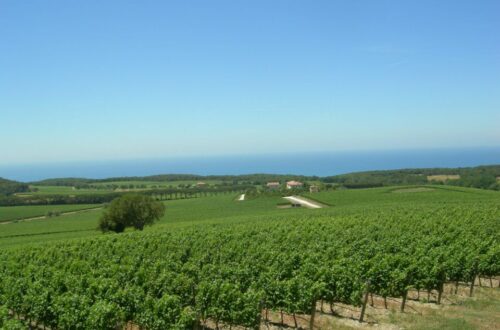Table of Contents
What is Aversa DOC?
In the shadow of Mount Vesuvius, where volcanic soils meet Mediterranean breezes, you’ll find one of Italy’s most unique wine traditions: Aversa DOC, home to the ancient Asprinio Bianco grape. Famous for its soaring vine-training method—where vines climb poplar trees up to 30 feet high—Aversa DOC produces crisp, vibrant Italian white wines and sparkling wines that are unlike any other in Campania, or indeed, Italy.
History and Origins
The origins of Asprinio di Aversa are ancient. Some ampelographers trace its roots back to Etruscan viticulture, while others suggest it was introduced by the Greeks or cultivated by the Romans. What’s certain is that Asprinio has been central to Naples’ wine culture for centuries, praised for its refreshing acidity that pairs beautifully with the region’s seafood-driven cuisine.
In the Middle Ages and Renaissance, Aversa’s noble families protected this unique grape, preserving the arboreal training system—a dramatic sight still visible today.
Where It’s Made: Geography & Terroir
The Aversa DOC zone straddles the provinces of Caserta and Naples, in northern Campania. Here, the terroir combines:
- Volcanic soils from ancient eruptions of Vesuvius
- Mediterranean climate with cooling breezes from the Tyrrhenian Sea
- Low-lying plains that retain moisture, giving the wines freshness
This terroir enhances Asprinio’s naturally high acidity, making it ideal for still and sparkling expressions.
The Grape: Asprinio Bianco
The star of Aversa DOC is Asprinio Bianco—a grape so rare it’s almost exclusively cultivated here. Known for its piercing acidity, citrusy profile, and mineral backbone, Asprinio makes both still wines and spumante (sparkling wines), often via the Charmat method but occasionally with traditional bottle fermentation.
Fun fact: “Asprinio” means “slightly sour,” a nod to its zesty character.
Winemaking & DOC Regulations
- DOC Established: 1993
- Styles Permitted: Still white, sparkling (spumante), and frizzante
- Minimum Asprinio Bianco: 85% (up to 15% other approved white grapes)
- Alcohol Levels: Typically 10.5–11.5% for still, 11–12.5% for sparkling
- Training System: Famous “vite maritata”—where vines climb poplars, requiring harvesters to scale ladders
Key Facts at a Glance
- Region: Campania, Italy (Naples & Caserta provinces)
- Primary Grape: Asprinio Bianco
- Wine Styles: Still white, sparkling, frizzante
- Flavor Profile: High acidity, citrus zest, green apple, mineral
- Price Range: $15–35 USD
- Best Producers: Grotta del Sole, I Borboni, Masseria Campito
Tasting Notes
- Appearance: Pale straw yellow
- Aroma: Citrus peel, green apple, lemon blossom, saline minerality
- Palate: Crisp acidity, refreshing, with a slight almond finish
- Sparkling Asprinio: More vibrant, with fine bubbles, lime zest, and a clean, dry finish
Serving & Pairing
Best Served: Well-chilled, around 8–10°C
Classic Pairings:
- Neapolitan pizza margherita
- Mozzarella di bufala from Campania
- Fresh seafood: fried anchovies, calamari, clams
- Seasonal pairings: grilled vegetables in summer, fried artichokes in spring
Holiday Pairings: Sparkling Asprinio is perfect with Christmas fritters or New Year’s seafood feasts.
Best Aversa DOC Wines to Buy in 2025
- I Borboni Asprinio Spumante Brut – benchmark sparkling expression
- Grotta del Sole Asprinio di Aversa DOC – still white with precision
- Masseria Campito Asprinio – elegant, mineral-driven
Aversa DOC vs Other Italian White Wines
Unlike softer Campania whites such as Greco di Tufo or Fiano di Avellino, Asprinio is sharper, leaner, and almost saline—closer to a Loire Muscadet or a crisp Vinho Verde than a rich southern Italian white. Its sparkling versions rival Prosecco in freshness but remain more artisanal and terroir-driven.
FAQ on Aversa DOC
What is Aversa DOC wine?
Aversa DOC is a wine appellation in Campania, Italy, dedicated primarily to Asprinio Bianco wines in both still and sparkling styles.
How is Asprinio wine made?
Typically via the Charmat method for sparkling, and stainless steel for still wines, preserving freshness and acidity.
What does Asprinio taste like?
High acidity, citrusy, mineral, with a clean, crisp finish.
How much does it cost?
Most bottles retail between $15–35 USD, making it an excellent value among Italian white wines.
Is Asprinio like Prosecco?
Both can be sparkling, but Asprinio is drier, leaner, and more mineral.
Fun Facts & Cultural Notes
- Harvesting Asprinio requires 30-foot ladders, a spectacle unique to Aversa.
- Asprinio’s acidity historically made it Naples’ favorite pizza wine.
- The “vite maritata” system is now protected as a cultural heritage practice.
Where to Buy & Pricing
Look for Aversa DOC wines at specialized Italian importers, online wine shops, or directly from producers. Average prices:
- Still Asprinio: $15–25
- Sparkling Asprinio: $20–35
Call to Action
Ready to taste one of Italy’s most authentic and rare wines?
👉 Explore our Italian Sparkling Wine Guide or sign up for the Drink Italian Wine Club to receive curated bottles of Aversa DOC delivered to your door.


